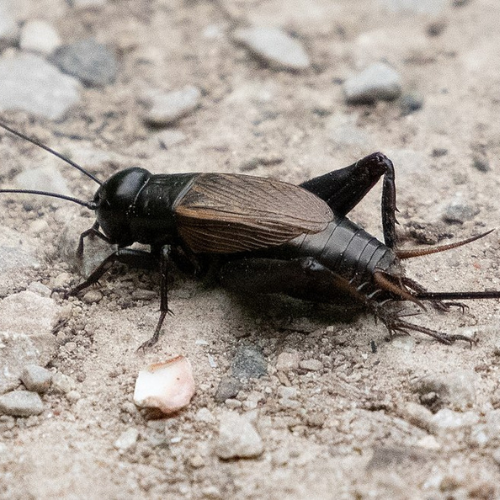Field Cricket
Introduction to
Field crickets are common insects known for their distinctive chirping sounds, which can be both a pleasant reminder of summer nights and a nuisance when they invade homes. These insects are typically found in fields, gardens, and occasionally inside buildings. While field crickets play a role in the ecosystem by helping decompose plant material and serving as food for predators, they can become pests when they damage crops, gardens, and household items. This article explores the recognition, biology, habits, prevention, and professional handling of field crickets, providing a comprehensive guide to understanding and managing these noisy insects.
Recognition
Field crickets are medium to large insects, ranging from 1/2 to 1 inch in length. They have a dark brown or black coloration, with long, slender antennae and powerful hind legs adapted for jumping. Male crickets are known for their chirping sounds, produced by rubbing their forewings together. This chirping is used to attract females and establish territory. Field crickets have a cylindrical body shape and are often found in grassy areas, under stones, or in garden debris. When indoors, they are usually found in basements, garages, and crawl spaces, where they seek warmth and shelter.
Biology
Field crickets belong to the family Gryllidae and are widely distributed across North America. They undergo incomplete metamorphosis, passing through three life stages: egg, nymph, and adult. Female crickets lay their eggs in the soil during late summer and fall. The eggs hatch into nymphs, which resemble small adults but lack wings. Nymphs undergo several molts before reaching maturity, a process that can take several weeks to months, depending on environmental conditions. Field crickets are omnivores, feeding on a variety of organic materials, including plants, seeds, and small insects. Their natural predators include birds, reptiles, and other insects.
Habits
Field crickets are primarily nocturnal and are most active during the evening and night. They are attracted to light and can often be found around outdoor lighting or inside homes that are well-lit at night. During the day, they seek shelter in cool, damp places such as under rocks, logs, and garden debris. Field crickets are known for their distinctive chirping, which males use to attract females and ward off other males. Indoors, their chirping can become a nuisance, especially when they invade living spaces. Field crickets can also cause damage by chewing on fabrics, paper, and other household materials.
Prevention
Preventing field crickets from entering your home involves reducing their attraction to the property and sealing potential entry points. Keep outdoor lighting to a minimum, or use yellow bulbs that are less attractive to insects. Seal cracks and gaps around windows, doors, and the foundation with caulk or weather stripping. Ensure that screens on windows and doors are in good repair. Reduce outdoor clutter and debris where crickets might hide, and maintain a tidy garden by regularly mowing the lawn and removing weeds. Using dehumidifiers in basements and crawl spaces can also help deter crickets by reducing moisture levels.
Professional
If field crickets become a persistent problem, professional pest control services can provide effective solutions. STL Pest Control offers comprehensive management plans to address field cricket infestations. Their experienced technicians will conduct a thorough inspection to identify entry points and areas of activity. They use targeted treatments, including baits and insecticides, to eliminate crickets and prevent their return. Additionally, STL Pest Control provides advice on long-term prevention strategies to keep your home cricket-free. Professional intervention ensures that field cricket problems are resolved quickly and efficiently, minimizing disruption and damage to your property.



Our Office








